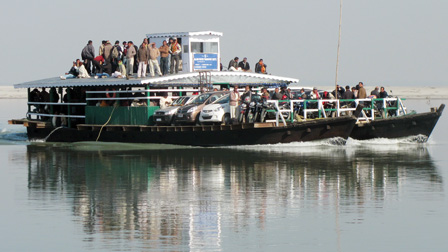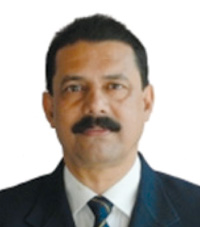Floating Hopes
Ratna Bharali Talukdar
 River transport - the apparently invisible transportation system in the promising road maps of connectivity owing to its sloth pace in Assam in particular and northeast in general - is poised for a change of track, towards better of course. Futuristic studies have been done and work plan are in the pipeline to improve the most underutilized mode of transportation in the region. Waterways, the prime mode of communication in terms of connectivity of human history since time immemorial, however, lost its horizon in India with incredible progress of roadways, railways and skyways- mostly after independence. It has become the transportation mode only for the poor and downtrodden, where other transport systems fail to connect them. Old and dilapidated vessels constructed way back in 1971
River transport - the apparently invisible transportation system in the promising road maps of connectivity owing to its sloth pace in Assam in particular and northeast in general - is poised for a change of track, towards better of course. Futuristic studies have been done and work plan are in the pipeline to improve the most underutilized mode of transportation in the region. Waterways, the prime mode of communication in terms of connectivity of human history since time immemorial, however, lost its horizon in India with incredible progress of roadways, railways and skyways- mostly after independence. It has become the transportation mode only for the poor and downtrodden, where other transport systems fail to connect them. Old and dilapidated vessels constructed way back in 1971
Innovation
He has made the bamboo boat by fitting the measured bamboo posts on a steal frame, following proper scientific chemical treatment of them to ensure durability. He has used locally available resin and kerosene oil as an adhesive to cover the gap between two bamboo posts inside the frame. The chemical treatment too, is an easy process, as one has to simply soak the bamboo pieces in lime-water at least for ten days. The 3.50 meter long and one meter broad bamboo-boat that Mahanta has designed and constructed, is much lighter than a wooden boat and therefore can travel faster. “If construction of a wooden boat is Rs.12 lakh, it can be brought down to about Rs.8 Lakh in case of boat made using bamboo. Besides, bamboo-boat is also more durable. Apart from reducing cost, it will also help in conservation of nature, and encourage local people to use this more convenient and easily available construction material. I have already submitted a project of such a machine-fit bamboo - boat for necessary recommendation”, says Mahanta, who is also inspired by the appeal of United Nation to use bamboo as a viable alternative of wood, owing to its maturity capacity at a tender age. The market price of per cft wood is at least Rs.1000/, while the same for bamboo is only Rs.50-Rs.100/ per cft, he says. |
without modern concepts of fuel efficiency, sufficient platforms for two-wheelers, and proper safety measures, still ferrying people between Guwahati and North-Guwahati by the department of Inland Water Transport (IWT) through river Brahmaputra that is used by around 10,000 people on average a day, speak volume of the apathy and negligence shown to this connectivity system. Condition of other ferry-ghats(terminals) located in different parts like Dhubri in lower Assam, Nimatighat in middle Assam and Sadiya in Upper Assam too, is no different. Thanks to the demand of the changing situation, a number of innovative and crucial steps have now been initiated to improve this mode of transport. With heavy and saturated traffic on roadways and railways, coupled with the high cost involved in surface transportation, it has become important to make this cheapest and most convenient connectivity system more visible with proper thrust, investment and upgradation. Waterways cost only 15 per cent of road transport and 54 per cent of railways in terms of energy efficiency, according to the recent study of “20 year Perspective Infrastructure Development Plan (PIDP)”, conducted by department of Planning and Development of Assam government. The PIDP study also reveals that the navigable route requires only 20 per cent of maintenance cost of that of road of equivalent capacity and costs low in terms of carriage with 21 per cent of road and 42 per cent of railways carriage costs. Further, it has been estimated that cost of development of inland waterways is only 5 to 10 per cent of the cost of developing an equivalent 4-lane highway or laying railway tracks. While the study has brought out such impressive figures, the reality is that only 3 per cent of the total cargo in Assam is being transported today using the waterways. The all India figure too, stands at a meager 3 per cent of total cargo transportation. Contrary to this, Germany and Bangladesh use their waterways for transportation of up to 20 per cent and 32 per cent of cargo traffic. PIDP, while studying the technical loopholes also simultaneously has worked out a phase-wise 20 year futuristic plan prioritizing amenities for increased number of passengers and to increase cargo traffic up to 10 per cent. It is expected that there would be sea- change in the scenario of water connectivity with infrastructure development and proper investment which is also expected to reduce transport bottle-neck.
next
-
In conversation with
Mr. Dhruba Hazarika, Commissioner, IWT
 Assam government has taken a number of initiatives to boost river connectivity. Correspondence has also been made with the Ministry of Shipping for considering development of waterway of a number rivers that connect Assam with Bhutan, Arunachal Pradesh and Mizoram. Assam has a total of 169 rivers, about 60 are tributaries to Brahmaputra, and about 12-15 are interstate rivers. With such correspondences going on, it is expected that seven more waterways is coming up soon in these rivers that are perennial throughout the year.
Assam government has taken a number of initiatives to boost river connectivity. Correspondence has also been made with the Ministry of Shipping for considering development of waterway of a number rivers that connect Assam with Bhutan, Arunachal Pradesh and Mizoram. Assam has a total of 169 rivers, about 60 are tributaries to Brahmaputra, and about 12-15 are interstate rivers. With such correspondences going on, it is expected that seven more waterways is coming up soon in these rivers that are perennial throughout the year.
Channel maintenance is a basic issue to make river communication convenient. The state government looks after the river breadth-wise, while the Inland Waterways Authority of India maintains the waterways lengthwise - the main channel lengthwise. IWT needs a lot to do to improve river transportation to offer quality service to passengers. On a random count we have nearly 9000 boats plying in the entire river stretches of the state. To conclude these into a modern set up, we have already worked out a mechanism. We are heading for high speed boats, introduction of Fiberglass Reinforce Plastic boats, among others – involving both government and private sector to usher development.
Such a modern set up is also aimed at promoting river tourism – an area, which is yet to be explored. At present, the IWT has successfully operating ‘MS Mahabahu’ - a large vessel on river Brahmaputra to promote tourism, which is a joint venture of government and private. The success story of this vessel has unfolded vast opportunities that lie in the field of river tourism in our state. With a number of schemes in the pipeline, we hope to achieve success in river connectivity shortly.
North eastern region has 1,800 kilometers of river routes on which vessels of different kinds of specification operate to serve over 54 lakh passengers, according to department of IWT, Assam. Passenger traffic is expected to increase to over one crore by 2020. The IWT has 212 different kinds of boats and vessels, of which only 68 are passenger carrying vessels and 39 are commercial vessels. Apart from the IWT vessels, over hundreds of machine-fitted country boats are used to ferry passengers at different points under the Panchayats. The National Waterways-2, the main course of the river Brahmaputra with a length of 891 kilometer, and proposed National Waterway -6, along the river Barak with a length of 121 kilometer are two main waterways in Assam. The majestic Brahmaputra that originates in the Chema yung dung and Kubi glaciers of Western Tibet near Mount Kailash and Mansarovar Lake and flows through Tibet, India and Bangladesh before merging into the Bay of Bengal, has a total length of 2,900 kilo-meters. With 40 major tributaries from the northern and 20 from southern banks along-with hundreds of sub-tributaries, rivulets and streams connecting to it, the river itself has become the most influential watercourse on life, livelihood and economy of people of different culture, creed and nation living on both sides of it. With 44 major rivers, the total length of Assam’s navigable waterway is estimated at 1,983 kilometer, out of the country’s 14,544 kilometer. It was way back in 1872 when Sir Henry Cotton remarked that India’s greatest need was for water transport for the railways could not carry the quantities expected of them, by stating “Steam boat canals would not have cost more than one eighth that of the railways; would carry any quantities at normal prices and at any speed; would require no support from the Treasury and be combined with irrigation.” It was also nearly half a century before him the British navigator and administrator Josh McCosh who discovered the route till Sadiya, one of the further navigable points on the river at the time (it still remains the last major port on the upstream route under a new name, Kundilghat) from Kolkata via Sirajgunj (currently in Bangladesh), said it took him all of 80 days or over 13 weeks to complete the journey (Source : Planning Commission). An Inland Waterways Authority of India (IWAI) study titled, “Identification of Potential Waterways in India” 2011, has identified various rivers including Dhaleswari, Jia Bharali, Buridihing, Dikhow, Dhansiri, Kopili / Kolong, and Disang in Assam, Dibang, Lohit, Siang and Subonsiri in Arunachal Pradesh, Khawthlangtuipui, Tuichawng and Tut in Mizoram, Kynshi, Simsang and Jingiram in Meghalaya, Gumti and Howrah in Tripura, Tizu in Nagaland, and Loktak having unique potential for waterways. Interestingly, Assam is the connecting point of most of these rivers with river Dhaleswari flowing through Mizoram, Dikhow and Dhansiri flowing through Nagaland, Jinjiram flowing through Meghalaya, and Barak through the hilly stretches of Manipur. All the rivers of Arunachal Pradesh too, ultimately culminate their journey into Brahmaputra in Assam. Currently the Sadiya - Saikhowa and Sadiya –Pagalam ferry services connect Assam and Arunachal Pradesh at upstream; the Nimati-Kamalabari-Lohit-Khabolu ferry services and Dhansiri- Gamiri ferry services connect three states including Assam - Arunachal Pradesh - Nagaland in central parts; the Jaleswar-Dhubri, Dhubri- Fakirganj and Phulbari-Dhubri ferry services connects Assam and Meghalaya in lower parts. These ferry services require immediate upliftment for comfortable and safe journey of passengers. The IWT Action Plan for NER Vision 2020 of the Ministry of Development of North Eastern Region (DONER), mentioned in RITES study titled “Identification of Potential Waterways in the North East India” has specifically identified the following rivers for promotion of waterways:
Sl. No. Rivers Navigable Length(km) 1. Burhidihing 161 2. Disang 129 3. Gadadhar 113 4. Subansiri 143 5. Kopili 103 6. Kolodyne 112 7. Kolong 121 8. Katakhal 161 9. Panchas 105 10. Others 1967 Waterways Passenger projection at different points up to 2035, PIDP
Terminal Current passenger Projection 2024-25 Projection 2034-35 Dhubri 1,85,144 3,01,580 4,91,242 Jogighopa 2,630 4,284 6,798 Goalpara 17,825 29,035 47,295 Neamati 45,654 74,365 1,21,134 Bhomoraguri 14,615 23,809 38,783 Dikhaumukh 6,130 9,941 16,193 Bogibeel 50,973 83,029 1,35,246 Dibrugarh 10,610 17,610 28,685 There are future possibilities of promoting waterways in a number of rivers including Lohit, Dibang, Subonsiri, Jiya Bharali, Manas, Beki and Gaurang on the northern bank and Burhi Dihing, Dokhaw, Dhansiri, Kopili/Kolong of Southern bank of river Brahmaputra; Dhaleswari and Katakhal tributaries of Barak rivers which require “channel survey and marking” according to vision 2020. All these, having unique opportunities of passenger and cargo transportation including tea, oil, coal, cement, gypsum, lime-stone, boulders, FCI products, industrial equipments, etc. are awaiting for time-bound intervention, network and investment for an efficient waterways in the land-locked northeastern region. The PIDP study highlights unique potentialities and utilization of Assam’s different terminals in river Brahmaputra and Barak as follows:
Dhubri : One of the busiest river port, this can significantly influence trade between India and Bhutan that stood at Rs. 3,046 Crore during 2013-14 and the trade between India and Bangladesh. The terminal currently handles varieties of cargo including jute,bamboo, coal, food grains, and other essential commodities.
Pandu : Strategically located and adjacent to the largest urban center Guwahati - the gateway of North-East, is low hanging fruit with two godowns, low level RCC jetty, multi-model connectivity with road and railways, and having possibilities for explorations for cargo transport from the proposed pharmaceutical hub and industrial park at Chaygaon, proposed chemical hub, industrial township in Amingaon that has potential to generate high cargo traffic.
Silghat : Having potential of transporting 70 per cent of total production of Numaligarh Refinary Limited, and the proposed industrial park at Nagaon.
Biswanath Ghat: Currently handling the FCI’s PDS cargo, it is estimated that FCI can transport over one MT of food grains, in addition to 2.4 Crore tonnes and 19 lakh tonnes of cement, iron and steel movement up to 2027.
Karimganj : Having possibilities of international connectivity with Bangladesh.
Jogighopa : Strategically located to serve NTPC power plant, as NTPC has plan to transport a huge share of imported coal from Bay of Bengal to Bongaigaon with IWT. Well connected with railways and roadways, and close to coal mines in Meghalaya.
Dibrugarh : Close to coal mines in Margherita that produces high quality coal, also serves an important urban center in Upper Assam and Arunachal Pradesh.
Badarpur : Is expected to attract traffic from cement, paper industries and coal transportation of Meghalaya and bamboo and bamboo products cargo from Lakhipur to Badarpur paper mills and further towards Bangladesh via IWT mode.
Uriamghat/Sengajan/Sadiya: are expected to transport Over Dimensional Cargo (ODC) movement of 2.5 MT per annum for the next 20 years for the proposed power generating projects of Arunachal Pradesh.
Most of these terminals are also expected to transport ODC for power plants, and large industries that are coming up in the region. The IWT wing of Ministry of Shipping records has shown a steady increase in cargo movement of National Waterway no II, that is river Brahmaputra during last five years, which stands at 1.83 lakh tonnes during 2009-10; 21.64 lakh tonnes during 2010-11; 24. 06 lakh tonnes during 2011-12; 24.27 lakh tonnes during 2011-12 and 24.75 during 2013-14.
The PIDP study has recommended creation of a statutory Inland Regulatory Authority, creation of Inland Waterways Development Corporation and IWT Commercial Corporation to enable it to take its own important decisions.
World Bank Project: Joint Director, Mosfiqur Rahman says the IWT has also submitted an ambitious 300 Million dollar concept note to World Bank, during 2013-14. An estimates cost of phase I covering 150 million Dollar (903.3 Crores) has been cleared. Ministry of Shipping has already recommended it, and the matter is with the Department of Economic affairs. The main components of the projects include:
- Long term strategic plan and feasibility studies for planning and development–Rs.31.11 Crore.
- Capacity Development – Rs 30.11 Crore
- Establishment of a Search and Rescue (SAR) organization –Rs 30.11 Crore
- Ferry Infrastructure and last minute connectivity – Rs. 421.54 Crore
- Fleet Modernization- Rs. 90.33 Crore
- Procurement of new vessels for select services- Rs. 150.55 Crore
- Development aid to navigation for 24 hour services on selected routes – Rs. 30.11 Crore.
In addition to these projects the IWT has also submitted another Rs.77 Crore project to introduce city based ferry services under the Jawaharlal Nehru Urban Renewal Mission, which is yet to materialize. The IWT has also introduced SMS monitoring system for IWT ferry services and also introduced GPRS based “Vessel Tracking System” in 66 vessels, keeping passenger safety in mind. Experts, however, say that realization of the dream of optimal utilization of the region’s rivers for connectivity will require strong political will and commitment from each northeastern states and huge funding by the Centre. But if and when it is realized, it can go a long way in addressing issues of climate change and environment protection as well.


 Tilak Chandra Mahanta, Executive Engineer, Guwahati Division of the IWT, has designed a unique model of bamboo-boat as a viable alternative version of indigenous country boats made out of wood, which, he claims, is not only cheaper but also durable. Mahanta’s innovation is a result of his prolonged study and observation regarding scarcity of seasoned wood to make machine-fitted country boats and high cost involved in it. Bamboo is an easily available product, grown in abundance in villages. The maturity period of a bamboo is between 4-8 years, contrary to a tree that requires at least 30 years to mature.
Tilak Chandra Mahanta, Executive Engineer, Guwahati Division of the IWT, has designed a unique model of bamboo-boat as a viable alternative version of indigenous country boats made out of wood, which, he claims, is not only cheaper but also durable. Mahanta’s innovation is a result of his prolonged study and observation regarding scarcity of seasoned wood to make machine-fitted country boats and high cost involved in it. Bamboo is an easily available product, grown in abundance in villages. The maturity period of a bamboo is between 4-8 years, contrary to a tree that requires at least 30 years to mature.